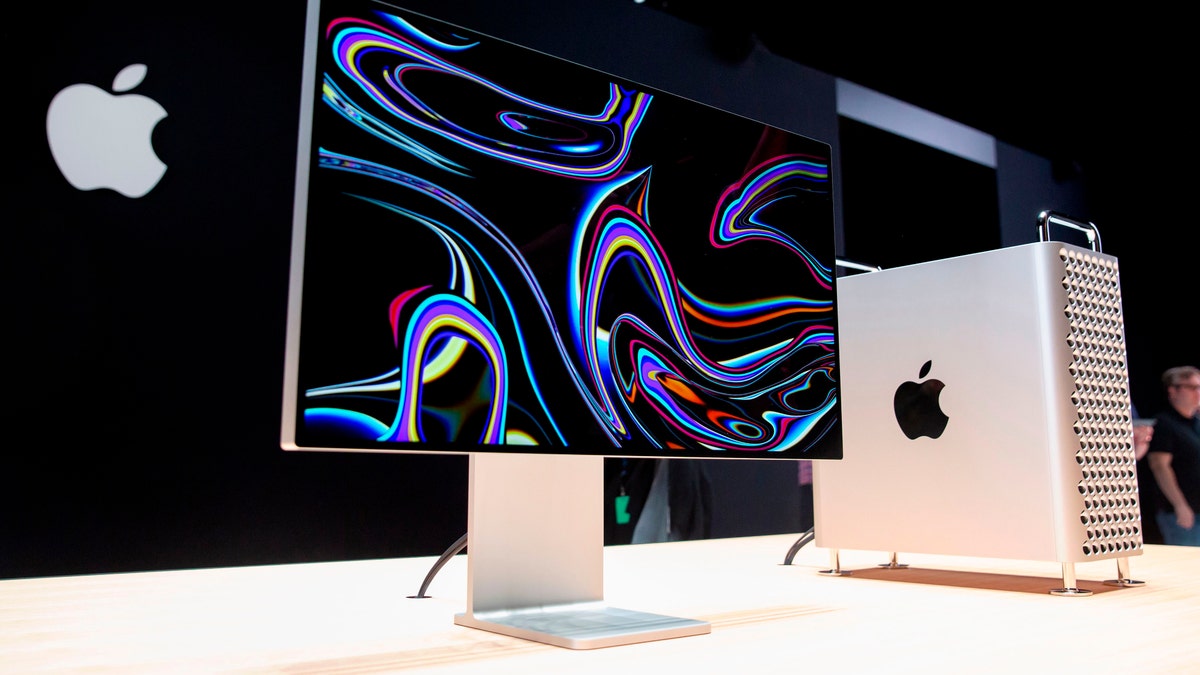
Apple's new Mac Pro sits on display in the showroom during Apple's Worldwide Developer Conference (WWDC) in San Jose, California on June 3, 2019. (Photo by Brittany Hosea-Small / AFP)
The wags have already chimed in: Apple's new Mac Pro looks like a giant cheese grater. But behind the aluminum casing is a configurable desktop PC made to easily add or swap out components.
The refreshed model has eight PCI Express slots—more than double the number on the last Mac Pro—so you can slide in additional graphics cards or other expansion cards, and use some new modular carrier hardware (which Apple dubs "MPX Modules") to outfit the machine with up to four extremely high-end workstation-grade GPUs.
A Configurable Monster
More From PCmag
If you need more RAM, no problem. The new Intel Xeon-based motherboard has 12 DIMM slots, which can be configured with up to 768GB or 1.5TB of RAM, depending on the CPU chosen. (Full specs can be found on Apple's website; Apple notes that the actual installable RAM maximum is 1TB or 2TB, the latter with the two highest-end Xeon CPU choices.)
Apple designed the Mac Pro to address any and all needs from professional users, such as software engineers, graphic designers, and data scientists. So the company focused on providing a solid foundation on which owners can build using modular parts. The result is a machine that looks nothing like the last Mac Pro, which sported a rounded, canister-like shell. Instead, the new model looks more like a standard desktop tower (more along the lines of the old Power Mac desktops), making it easier to swap in off-the-shelf components. (The "grater" front is all about maximizing inbound airflow for what could be some truly outrageous component loadouts.)
You'll also be able to buy the upgrades from Apple. The company plans to sell them as modular components, including the AMD Radeon GPUs and SSD storage. Owners can also add Apple's custom-made Afterburner video-editing card—another modular component—which can let you play back three 8K video streams simultaneously. The card will also accelerate the ProRes and ProRes RAW codecs in supported software, such as Final Cut Pro X.
Xeon Power, From Eight Cores to 28 Cores
One area where Apple won't offer upgrades to the new Mac Pro is with the Intel Xeon processors; you'll configure these at time of purchase. Still, the product is built using industry standards, so owners should be able to upgrade the Intel chips over time if they feel comfortable digging into the computer's motherboard.
(Photo by Justin Sullivan/Getty Images)
The base-model Mac Pro starts with an eight-core 3.5GHz Intel Xeon W processor. But you can max out a machine with a 28-core Intel Xeon W. (Apple doesn't specify which exact CPU is that peak model, but judging by the 2.5GHz base clock, it looks like the Xeon W-3275 or W-3275M.) Plus, you can opt for a single-GPU ("Radeon Pro Vega II") card or a dual-GPU ("Radeon Pro Vega II Duo") card in each of the potential two MPX modules, which can net you up to four GPUs and up to 128GB of video memory, with 32GB from each GPU.
All that power also means the system needs plenty of cooling. So the company resorted to placing a bunch of holes across the outer aluminum casing to maximize airflow, and three huge fans pull in air through the perforated front. We'll have to wait until we get the Mac Pro into PC Labs to really judge performance. At WWDC, the company only let journalists and developers look at the Mac Pro; no touching allowed.
But Apple clearly went out of its way to create a powerhouse workstation to fit any conceivable need among heavy-duty users. The only major roadblock is the price. The new Mac Pros will start at $5,999—or twice the cost of the 2013 model.
One Very Prime Panel
Complementing the refreshed hardware is an upcoming 32-inch Apple monitor. The Pro Display XDR is a 6K screen with a 6,016-by-3,384-pixel native resolution. Interestingly, Apple opted to use LCD panel technology—not OLED—to create the monitor. Nevertheless, it can project high-contrast colors and deep blacks on par with OLED screens, based on what we saw at WWDC.
The product's other selling point is the brightness. It can sustain images at 1,000 nits throughout the day, with peak brightness reaching 1,600 nits. The colors on the panel will also remain accurate and avoid taking on a warmer, orange shade when at higher brightness. (Full specs can be found on Apple's website.)
Alas, the Pro Display XDR also has a wildly high price point. It'll go for $4,999, while a special adjustable stand for the monitor is another $999. That means when bought together, one Mac Pro can set you back $12,000, or enough to buy a new car.
Apple didn't reveal the price of a fully maxed-out Mac Pro, but the company will announce more pricing details when the products launch this fall.
This article originally appeared on PCMag.com.
